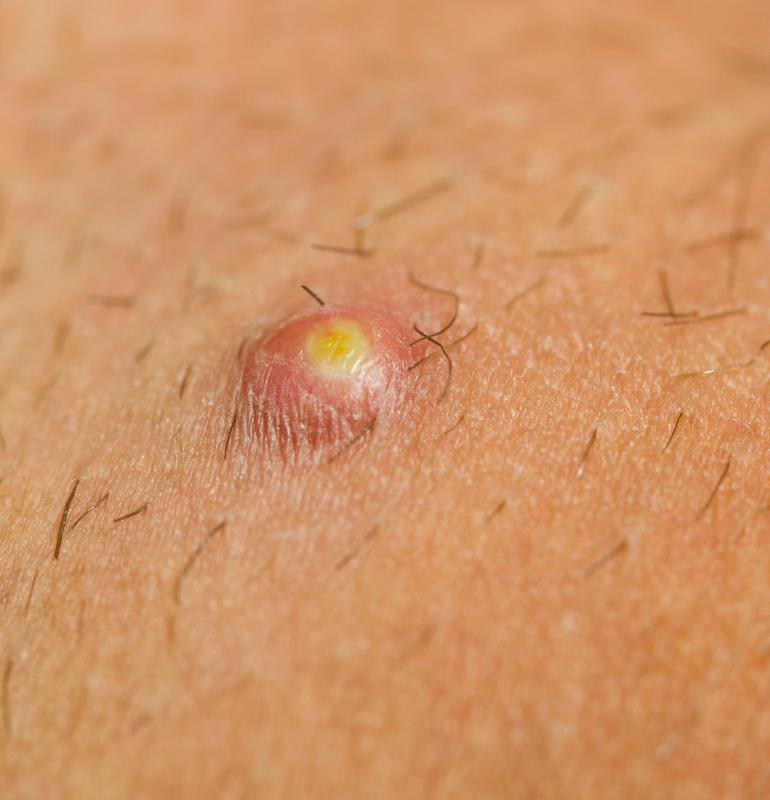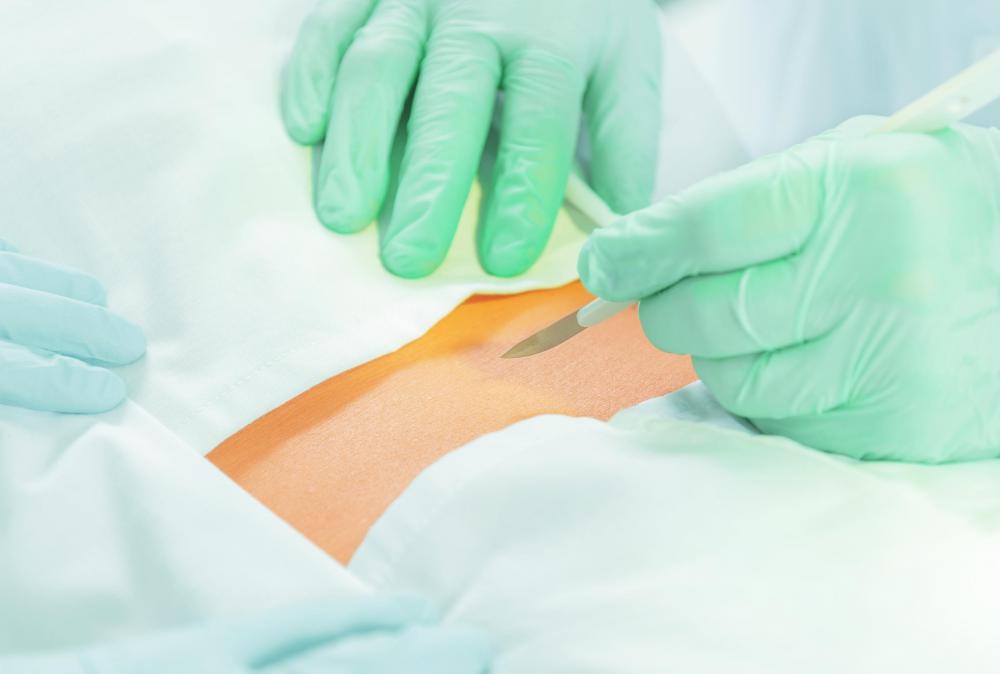At WiseGEEK, we're committed to delivering accurate, trustworthy information. Our expert-authored content is rigorously fact-checked and sourced from credible authorities. Discover how we uphold the highest standards in providing you with reliable knowledge.
What Is Incision and Drainage?
Incision and drainage is a simple treatment for cutaneous abscesses located in the upper layers of the skin. It may be routinely recommended for mild to moderate cases and usually requires a quick visit to a doctor’s office or clinic. After the procedure, the doctor may place a drain or recommend antibiotics if the abscess was particularly large. Otherwise, it should heal on its own with minimal disruption for the patient.
Abscesses occur when buildups of fluid develop below the skin, causing a swelling that may turn hot and inflamed. A small deposit of fluid may drain on its own if the patient applies regular hot compresses. If this is not effective, an incision and drainage may be required to address the problem. Care providers can perform this procedure very quickly and the risks are low, although with larger sites there can be concerns about infection.

This starts with cleaning the area to limit the chance of infection by swabbing it with antiseptic or gently washing it. Care providers wash their hands and apply gloves so they can lance the swelling with a sharp instrument. Gauze may be placed below the site to catch pus, which can squirt out when the pressure is relieved. Incision and drainage can require the application of pressure to squeeze matter out of the wound, and the insertion of a small probe to loosen any clots of material. The wound can be washed and bandaged to finish the procedure.

In the event of a large swelling that runs more deeply under the skin, the care provider might recommend placing a drain after incision and drainage. A small tube can be placed and taped or stitched into place to allow fluid to drain out of it over the next few days. As the site heals, the tube can be withdrawn. Antibiotics can also be recommended if the care provider is worried about the risk of infection after incision and drainage.

The simplicity of this procedure may lead patients to try it at home. This can be risky, because they may introduce infectious material while lancing the swelling, or could hit a delicate structure like a nerve. Home care for abscesses can start with warm compresses and if this is not effective, a care provider can be consulted on the next step. These conditions do not resolve on their own and it is important to get treatment to prevent complications caused by large swellings that may eat into underlying tissues.
AS FEATURED ON:
AS FEATURED ON:
















Discussion Comments
@Oceana - Cystic acne is considered a type of abscess. These are those bumps that develop deeper under the skin. They appear red for several days before any head forms, and the area is very tender to the touch.
I had this type of acne a few years ago. I went to a dermatologist, and he performed incision and drainage on the biggest bumps.
I was surprised that he did this, because I had heard the same thing as you about how it can cause scars. He told me that since those areas were so deeply inflamed by the trapped debris, the pus needed to be forcefully removed.
He did tell me not to try it at home, though. He had a certain method for doing it to prevent scarring.
Does anyone know if acne is considered to be a type of abscess? The bumps are definitely red and filled with pus, so I wonder if that qualifies them for this category.
I know that I have to personally puncture and drain my acne at times. If I don't, I just get unsightly white bumps that sit atop the reddened areas and call attention to themselves.
I have always read that you shouldn't squeeze acne, because this could lead to scarring. However, I just can't tolerate those bulging bumps of pus on my face. I usually stick a needle in them and then squeeze them with two cotton swabs to get all the junk out.
Mysterious abscesses can be scary. My friend had one appear on her leg, and though she knew the events leading up to it, she didn't know why the area filled with fluid.
She was pushing a grocery cart when she had to come to an abrupt stop to avoid hitting someone. When she did, she rammed her shin into the bar along the bottom of the cart. She said it hurt so much that it brought tears to her eyes.
The area bruised, but a hard knot also formed there. Within a week, the area became squishy, as though it contained pus.
Her doctor cut and drained the area, and he thought this would be enough. It kept getting bigger and worse, though. She went back to him, and he injected it with a steroid shot. This was the only thing that helped.
My husband had to have incision and drainage for his nasty spider bite a few years ago. He didn't even know he had been bitten until his sister saw the area and told him what it was. She knew he would need to have the area drained of pus.
The doctor made an incision with a scalpel after deadening the area. Then, she found that she needed to cut even more damaged tissue out. After that, she pushed repeatedly to drain the area of pus.
She packed the hole with gauze, and she told him to come back soon to have it redressed. He said that when he returned and she began repacking the hole with fresh gauze, the pain was too much to bear. He had to ask her to be more gentle.
Poisonous spider bites are bad news. They almost always require incision and drainage to keep the flesh from rotting.
Post your comments